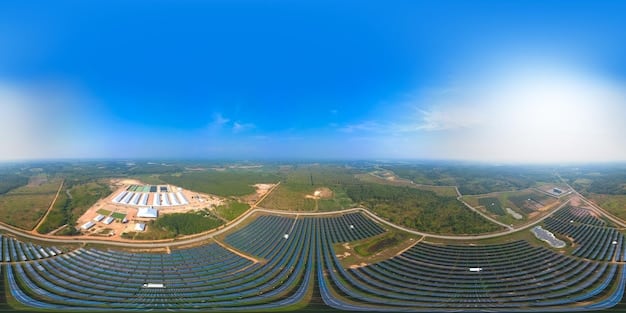New Tax Credits Under Inflation Reduction Act for Renewable Energy

Anúncios
The Inflation Reduction Act introduces substantial new tax credits, significantly enhancing the financial appeal of renewable energy investments by offering direct incentives for households and businesses adopting clean energy solutions across the United States.
Anúncios
In the evolving landscape of climate policy and fiscal incentives, the Inflation Reduction Act (IRA) stands out, fundamentally reshaping how individuals and businesses approach clean energy investments. This legislation introduces a suite of significant tax credits aimed at accelerating the transition to a sustainable future, making Understanding the New Tax Credits for Renewable Energy Investments Under the Inflation Reduction Act crucial for anyone considering such ventures.
The Genesis of Change: The Inflation Reduction Act’s Vision
The Inflation Reduction Act of 2022 represents a landmark piece of legislation in the United States, designed to address a multitude of national challenges, from climate change and healthcare costs to energy security and inflation. While its scope is broad, a significant portion of its provisions is dedicated to fostering the growth of renewable energy and clean technologies. This commitment is underpinned by a strategic understanding that a cleaner energy grid not only mitigates environmental impact but also bolsters economic resilience and creates new opportunities for American innovation and job creation.
The Act’s vision for renewable energy is multifaceted, encompassing a renewed emphasis on domestic manufacturing, innovation, and widespread adoption. It aims to reduce greenhouse gas emissions by approximately 40% below 2005 levels by 2030, a target that relies heavily on a rapid shift away from fossil fuels. To achieve this ambitious goal, the IRA introduces an unprecedented scale of financial incentives, primarily in the form of tax credits, designed to make clean energy solutions more accessible and affordable for a diverse range of stakeholders. This comprehensive approach recognizes that the transition to a renewable energy economy requires both large-scale industrial shifts and widespread individual participation.
Anúncios
Driving Innovation and Investment
The legislative framework of the IRA is carefully constructed to stimulate investment across the entire renewable energy value chain. It incentivizes everything from the production of clean energy components—such as solar panels and wind turbine parts—to the deployment of advanced energy storage systems and the electrification of transportation. This holistic strategy acknowledges that sustainable growth in the clean energy sector requires a robust ecosystem of innovation, manufacturing, and consumption.
Furthermore, the Act seeks to level the playing field for renewable energy technologies against traditional fossil fuels by offering long-term tax certainty. This is particularly important for large-scale energy projects that typically require significant upfront capital and have long payback periods. By providing stability and predictability in tax policy, the IRA encourages private sector investment in projects that might otherwise be deemed too risky or financially unviable.
- Long-term tax credit extensions for solar and wind projects.
- New credits for emerging clean technologies like hydrogen.
- Incentives for domestic manufacturing of renewable energy components.
- Provisions to enhance energy storage and grid modernization.
This foundational understanding of the IRA’s purpose is essential for appreciating the subsequent discussion on specific tax credits. It sets the stage for how these financial tools are intended to translate broad policy objectives into tangible actions at both the industrial and individual level. The ultimate aim is to create a virtuous cycle where increased demand for renewable energy drives innovation, leading to lower costs, and further accelerating adoption.
Residential Renewable Energy Tax Credits: What Homeowners Need to Know
For homeowners, the Inflation Reduction Act brings exciting news in the form of enhanced and extended tax credits that significantly reduce the cost of installing renewable energy systems. The flagship incentive for residential solar installations, the Investment Tax Credit (ITC), has been revitalized and renamed the Clean Energy Tax Credit (CETC) in some contexts, offering a substantial credit for eligible expenses. This is a crucial area for homeowners looking to make their properties more sustainable and energy-independent.
The primary incentive for residential renewable energy is the ITC, now effectively set at 30% for systems placed in service starting January 1, 2022, through December 31, 2032. This includes solar panels, battery storage, small wind turbines, and geothermal heat pumps. Unlike a deduction, a tax credit directly reduces the amount of income tax you owe, dollar for dollar, making it a powerful financial tool for homeowners considering these upgrades. The credit then steps down to 26% in 2033 and 22% in 2034 before expiring. There is no maximum cap on the amount of credit you can claim, making larger installations equally attractive from a percentage standpoint.
Beyond solar, the IRA extends credits to other clean energy technologies for the home. This includes a 30% credit for geothermal heat pumps, which provide both heating and cooling by exchanging heat with the earth, and small wind energy systems. Additionally, battery storage technology, when installed in conjunction with a renewable energy system, also qualifies for the 30% tax credit. This is particularly beneficial for homeowners seeking greater energy independence and resilience against power outages.
The Act also introduces specific incentives for energy efficiency home improvements. While not strictly “renewable energy,” these measures often complement renewable installations by reducing overall energy demand. For instance, the Energy Efficient Home Improvement Credit (25C) offers a credit of 30% of the cost of certain energy-efficient home improvements, up to a maximum of $1,200 annually, with specific caps for certain items like highly efficient windows and doors. This can be combined with the renewable energy credits, offering a comprehensive package of financial support for sustainable home upgrades.
Key Residential Credits for Homeowners
Understanding the specific nuances of each credit is vital for maximizing benefits. The residential clean energy credit (part of the larger ITC framework) is a non-refundable credit, meaning it can reduce your tax liability to zero, but you won’t get a refund of any excess credit. However, any unused credit can be carried forward to future tax years, ensuring that homeowners can gradually utilize the full value of the incentive.
- Solar Photovoltaic Systems: 30% credit for the cost of installing solar panels.
- Battery Storage Technology: 30% credit for battery storage with a capacity of at least 3 kWh.
- Small Wind Energy Systems: 30% credit for small wind turbines.
- Geothermal Heat Pumps: 30% credit for qualified geothermal heat pump property.
- Energy Efficiency Upgrades: Up to $1,200 annually for certain efficiency improvements (e.g., insulation, efficient windows).
It’s important for homeowners to consult with a qualified tax professional to understand how these credits apply to their specific situation and to ensure proper documentation and filing. The IRS provides detailed guidance, and installers of renewable energy systems are often well-versed in the requirements. These provisions represent a significant opportunity for homeowners to reduce their environmental footprint while also enhancing the value and resilience of their homes.
Commercial and Utility-Scale Opportunities: Extended and Enhanced Credits
Beyond residential applications, the Inflation Reduction Act substantially overhauls and enhances tax incentives for commercial and utility-scale renewable energy projects. This is critical for driving the large-scale deployment of clean energy needed to transform the national grid. The Act largely extends and reforms the existing Production Tax Credit (PTC) and Investment Tax Credit (ITC), making them more robust and accessible. These credits are designed to incentivize vast investments in projects ranging from solar farms and wind turbine arrays to advanced manufacturing facilities and carbon capture technologies.
The PTC offers a credit for each kilowatt-hour of electricity produced by eligible renewable energy facilities for the first ten years of operation. The base credit amount is tied to inflation, but the IRA introduces a significant bonus: projects meeting certain prevailing wage and apprenticeship requirements can qualify for a five-fold increase in the base credit. This incentivizes good-paying jobs and the training of a skilled clean energy workforce. Similarly, the ITC offers a credit equal to a percentage of the capital cost of building renewable energy facilities. For commercial solar and wind, the base credit is 6%, but it can be increased to 30% if prevailing wage and apprenticeship requirements are met.
What’s particularly transformative for large-scale projects is the introduction of “bonus credits.” Projects located in certain “energy communities” (areas with significant fossil fuel employment or brownfield sites) can receive an additional 10% ITC. Furthermore, projects that use a certain percentage of domestically produced steel, iron, or manufactured products can qualify for another 10% bonus. These add-ons significantly enhance the financial viability of projects, especially those in economically distressed areas or those committed to strengthening domestic supply chains.

Direct Pay and Transferability: Game Changers for Developers
Two of the most significant innovations for commercial entities under the IRA are “direct pay” and “transferability” provisions. Historically, tax credits were only valuable to entities with sufficient tax liability to claim them. Non-profits, governmental entities, and new businesses with little or no tax liability often could not fully utilize these credits.
- Direct Pay (Elective Pay): Allows certain entities (tax-exempt organizations, state and local governments, tribal governments, rural electric cooperatives) to receive direct payment from the IRS for the full value of the tax credits, even if they have no tax liability. This dramatically expands who can benefit from clean energy investments.
- Transferability: Allows eligible taxpayers to sell all or a portion of certain clean energy tax credits to an unrelated third party for cash. This creates a new market for tax credits, enabling developers of renewable energy projects to monetize their credits quickly and efficiently, regardless of their own tax appetite.
These provisions are expected to unlock billions of dollars in new investment, particularly from entities that previously couldn’t fully leverage tax incentives. Direct pay means schools, hospitals, and municipal utilities can directly benefit from installing clean energy, while transferability offers a flexible financing mechanism for developers, speeding up project deployment. The strategic intent is clear: remove financial barriers and maximize the impact of every clean energy dollar invested.
Electrification and Energy Efficiency Incentives: Beyond Generation
The Inflation Reduction Act’s impact on clean energy extends well beyond the direct generation of renewable electricity to encompass broader electrification and energy efficiency initiatives. Recognizing that merely producing clean power is not enough if it’s not used efficiently or in electrified systems, the IRA allocates substantial resources to encouraging the adoption of electric vehicles (EVs), electrifying homes and businesses, and improving overall energy efficiency across various sectors. This holistic approach aims to reduce fossil fuel consumption comprehensively, from transportation to residential heating.
For individual consumers, the Act offers significant tax credits for the purchase of new and used clean vehicles. The new clean vehicle credit provides up to $7,500 for eligible new EVs, while a separate credit offers up to $4,000 for qualifying used EVs. These credits have specific criteria related to critical mineral sourcing, battery component manufacturing location, and vehicle manufacturing in North America, designed to bolster domestic supply chains. This incentivizes consumers to switch from gasoline-powered vehicles, directly reducing emissions from the transportation sector, which is a major contributor to greenhouse gases.
In the realm of home energy, the IRA introduces and expands various incentives to help households electrify their heating, cooling, and appliances. The High-Efficiency Electric Home Rebate Program, for example, provides point-of-sale consumer rebates for low- and moderate-income households to electrify their homes. This includes rebates for heat pump water heaters, heat pump HVAC systems, electric stoves, and electric clothes dryers, among other things. The aim is to make efficient electric appliances more affordable, reducing reliance on fossil fuels like natural gas for residential use.
Strategic Electrification for Businesses and Infrastructure
For businesses, the IRA offers a range of incentives to support electrification of fleets, industrial processes, and commercial buildings. The Clean Commercial Vehicle Credit provides a tax credit for the purchase of qualified clean commercial vehicles, depending on the vehicle’s weight and clean powertrain. This encourages businesses to transition their delivery and service fleets to electric or hydrogen-powered alternatives, significantly impacting urban air quality and operational emissions.
- Clean Vehicle Credits: Up to $7,500 for new EVs and $4,000 for used EVs (with specific criteria).
- Home Electrification Rebates: Significant rebates for heat pumps, electric stoves, and other electric appliances for eligible households.
- Commercial Vehicle Credits: Incentives for businesses to adopt clean commercial vehicles.
- Alternative Fuel Refueling Property Credit: Extended credit for installing EV charging stations and other alternative fuel infrastructure.
- Energy Efficient Commercial Buildings Deduction (179D): Enhanced deduction for energy-efficient property placed in service in commercial buildings.
Furthermore, the Act provides a critical boost to the necessary infrastructure supporting electrification. The Alternative Fuel Refueling Property Credit offers a 30% tax credit (up to $1,000) for the cost of installing charging stations for electric vehicles or other alternative fuel vehicles at home. For businesses, a separate credit allows for up to 30% of the cost of qualified alternative fuel refueling property, with no cap, which is crucial for deploying charging networks and hydrogen fueling stations. This comprehensive approach to electrification and efficiency lays the groundwork for a truly integrated clean energy economy, where clean power is generated, stored, and efficiently consumed.
Navigating the Specifics: Eligibility, Documentation, and Timelines
Understanding the broad strokes of the Inflation Reduction Act’s tax credits is only the first step; navigating the specifics of eligibility, documentation, and key timelines is crucial for successfully claiming these incentives. The complexity of tax law means that small details can significantly impact whether a credit is available and how much can be claimed. Diligent record-keeping and careful adherence to IRS guidelines are therefore paramount for both homeowners and businesses.
For residential tax credits, the primary eligibility requirement is that the renewable energy system or energy-efficient improvement must be new and placed in service during the eligible period. For solar, for instance, this means the installation must be completed and operational. The credit is claimed on IRS Form 5695, “Residential Energy Credits,” which is filed with a taxpayer’s federal income tax return. Homeowners must keep records of all expenses related to the installation, including invoices for equipment and labor, as these are necessary to calculate the credit amount correctly. It’s also important to note that the credit is generally based on the net cost after any utility rebates but before any state or local incentives.
Commercial and utility-scale projects face more intricate requirements. For the enhanced PTC and ITC, meeting prevailing wage and apprenticeship requirements is often a key differentiator between a base credit and a significantly higher one. Developers must meticulously document compliance with these labor standards, which involves paying workers wages that are no less than the prevailing wages for construction, alteration, or repair of similar character in the locality, and ensuring a certain percentage of total labor hours are performed by qualified apprentices. Failure to meet these requirements can lead to a substantial reduction in the credit.
Important Deadlines and Requirements
The timelines for these credits vary. Most of the enhanced residential and commercial clean energy credits are extended through 2032, providing long-term certainty for planning and investment. However, some specific provisions may have earlier or later expiration dates or stepped-down credit percentages. Staying informed about these nuances is essential for maximizing benefits.
- Prevailing Wage and Apprenticeship: Required for full commercial ITC/PTC. Documentation is critical.
- Domestic Content Requirements: Bonus credits available for meeting specific percentages of domestically manufactured components.
- Energy Community Bonuses: Eligibility tied to project location in designated areas.
- Filing Forms: Specific IRS forms (e.g., Form 5695 for residential, Form 3468 for business investment credit) are required.
For commercial projects seeking direct pay or transferability, there are additional registration and reporting requirements. Entities electing direct pay must pre-register with the IRS, and transfers of credits must be properly documented. This ensures transparency and prevents fraud. Given the significant financial implications, it’s highly advisable for large-scale project developers to engage with tax attorneys and financial advisors specializing in clean energy finance to ensure full compliance and optimization of credit benefits. The specifics of the law are periodically updated, so continuous monitoring of IRS guidance and industry best practices is also a crucial aspect of successful implementation.
Economic and Environmental Ripple Effects: Beyond the Balance Sheet
The impact of the Inflation Reduction Act’s renewable energy tax credits extends far beyond individual balance sheets and corporate ledgers. These financial incentives are designed to generate profound economic and environmental ripple effects across the nation, accelerating the transition to a sustainable economy, fostering domestic industry, and combating climate change on a significant scale. Understanding these broader consequences is essential for grasping the truly transformative potential of the IRA.
Economically, the Act is poised to stimulate massive private sector investment in the clean energy sector. By making renewable energy projects more financially attractive, the credits encourage the construction of new solar farms, wind power facilities, battery storage plants, and manufacturing facilities for clean energy components. This, in turn, is expected to create hundreds of thousands of new jobs in manufacturing, construction, installation, and maintenance across various industries. These aren’t just jobs building renewable energy infrastructure; they also include positions in related fields such as mining for critical minerals, advanced materials science, and grid modernization. The emphasis on domestic content and prevailing wages further ensures that these economic benefits are retained within American communities.
Environmentally, the most direct and crucial impact is the projected reduction in greenhouse gas emissions. By incentivizing a rapid shift from fossil fuels to clean energy, the IRA aims to put the U.S. on a credible path to achieve its climate targets. Increased renewable energy generation means less reliance on coal and natural gas power plants, leading to significant reductions in carbon dioxide, methane, and other air pollutants. This not only mitigates global warming but also improves local air quality, leading to better public health outcomes, particularly in communities historically burdened by pollution from fossil fuel facilities.
Building a Resilient and Sustainable Future
Beyond immediate job creation and emissions reductions, the IRA’s clean energy provisions contribute to long-term energy security and geopolitical stability. By fostering domestic clean energy production and supply chains, the U.S. reduces its dependence on volatile global energy markets and foreign adversaries. This enhanced energy independence translates into greater economic stability and national security.
- Job Creation: Hundreds of thousands of new jobs in clean energy manufacturing, installation, and related sectors.
- Emissions Reduction: Significant reduction in greenhouse gas emissions from the energy sector.
- Energy Security: Decreased reliance on fossil fuels and foreign energy sources.
- Technological Advancement: Incentives for innovation in battery storage, hydrogen, and other emerging clean technologies.
- Community Benefits: Targeted investments in energy communities for equitable economic transition.
The Act’s support for emerging clean technologies, such as clean hydrogen and carbon capture, also lays the groundwork for future breakthroughs and further decarbonization of hard-to-abate sectors like heavy industry and long-haul transportation. This investment in innovation ensures that the U.S. remains at the forefront of the global clean energy transition, developing and deploying the next generation of sustainable solutions. By intertwining economic incentives with environmental goals, the Inflation Reduction Act aims to engineer a systemic transformation that benefits both present and future generations, establishing a more resilient, sustainable, and prosperous trajectory for the nation.
Future Outlook: Sustainability and Long-Term Impact
As the Inflation Reduction Act’s renewable energy tax credits begin to take full effect, the future outlook for sustainability in the United States appears significantly brighter. The long-term extensions of these credits provide much-needed policy certainty, which is crucial for attracting sustained private investment and accelerating the pace of clean energy deployment. This stability allows businesses and individuals to plan multi-year projects with confidence, rather than facing the uncertainty of expiring incentives. The effects are expected to compound over time, creating a virtuous cycle of innovation, deployment, and cost reduction in clean energy technologies.
One of the most anticipated long-term impacts is the accelerated decline in the cost of renewable energy. As deployment scales up, manufacturing processes become more efficient, and technological advancements continue, the levelized cost of energy from solar and wind is expected to become even more competitive with, and eventually cheaper than, traditional fossil fuels. This trend will make renewable energy the default choice for new power generation capacity, irrespective of subsidies, primarily driven by economic factors. The IRA acts as a catalyst, speeding up this transition by bridging the current cost gap and de-risking early large-scale projects.
Furthermore, the Act’s emphasis on domestic manufacturing and supply chains is poised to strengthen the U.S. clean energy industrial base. This not only creates jobs but also enhances economic resilience by reducing reliance on foreign supply chains, which have proven vulnerable to global disruptions. Over time, this could lead to the U.S. becoming a net exporter of clean energy technologies, fostering a new era of industrial leadership. The consistent demand stimulated by the tax credits will drive investment in U.S. factories and innovation centers, building a robust ecosystem for clean technology.

Policy Evolution and Global Context
While the IRA provides a strong foundation, the landscape of clean energy policy is always evolving. Future legislative efforts may build upon the IRA’s framework, introduce new incentives for nascent technologies, or adjust existing ones based on market developments and global climate goals. The ongoing challenge will be to ensure that policy mechanisms remain agile and effective in addressing emerging needs and opportunities in the energy transition.
The global context also plays a crucial role. As other nations implement their own climate policies and invest in clean energy, the U.S.’s commitments under the IRA help foster international collaboration and accelerate global decarbonization efforts. The competitive environment spurred by these investments can drive innovation worldwide, leading to more accessible and affordable clean energy solutions for everyone. Ultimately, the future outlook suggests a U.S. energy landscape increasingly dominated by clean, domestically produced power, with significant benefits stemming from its economic, environmental, and strategic dimensions. The path ahead is complex, but the IRA has laid a powerful foundation for a more sustainable and prosperous future.
| Key Aspect | Brief Description |
|---|---|
| ☀️ Residential Credits | 30% tax credit for solar, battery storage, and other home clean energy systems. |
| ⚡ Commercial Incentives | Extended ITC/PTC with bonuses for domestic content, prevailing wages, and energy communities. |
| 💸 Direct Pay & Transferability | Allows non-taxable entities to receive cash for credits, and for credits to be sold to third parties. |
| 🚗 Electrification Support | Credits for new and used EVs, and rebates for home electrification appliances. |
Frequently Asked Questions About IRA Tax Credits
As a homeowner, the primary benefit is the 30% Clean Energy Tax Credit for eligible renewable energy systems, including solar panels. This credit directly reduces your federal income tax liability dollar-for-dollar by 30% of the cost of your solar installation, without a cap. It’s a significant financial incentive designed to make solar energy more affordable and accessible for residential properties, with carry-forward provisions allowing you to use unused credit in future tax years.
For businesses, the IRA extends and enhances tax credits like the Investment Tax Credit (ITC) and Production Tax Credit (PTC) for utility-scale projects. It introduces bonus credits for meeting prevailing wage, apprenticeship, domestic content, and energy community requirements. Most notably, it offers “direct pay” for tax-exempt entities and “transferability” of credits, allowing developers to sell credits for cash, significantly improving project financing and attracting more investment into large-scale renewable energy infrastructure.
Yes, the IRA provides tax credits for both new and used clean vehicles. The new clean vehicle credit offers up to $7,500, and the used clean vehicle credit offers up to $4,000. Key conditions include the vehicle’s manufacturing location, battery component sourcing, and critical mineral content within its battery. These requirements are designed to encourage domestic production and strengthen U.S. supply chains for electric vehicle technology, promoting broader adoption of sustainable transportation.
“Direct pay” (or elective pay) allows eligible tax-exempt entities (like non-profits or governments) to receive the cash value of tax credits directly from the IRS, even without tax liability. “Transferability” permits eligible businesses to sell their tax credits to unrelated third parties for cash. These provisions are crucial because they broaden access to clean energy incentives, enabling a wider range of organizations to invest in renewable projects and creating new financing mechanisms for developers, thus accelerating clean energy deployment.
Most of the significant clean energy tax credits for both residential and commercial projects, such as the 30% Investment Tax Credit for solar and the Production Tax Credit, have been extended for a decade, through December 31, 2032. This long-term extension provides crucial certainty for planning and investment in the renewable energy sector, fostering stability and encouraging sustained deployment over the coming years, before potentially stepping down in subsequent years.
Conclusion
The Inflation Reduction Act represents a pivotal moment in U.S. energy policy, offering a transformative suite of tax credits designed to accelerate the nation’s transition to a clean energy economy. From empowering homeowners with significant savings on solar installations to revolutionizing financing for utility-scale projects, the legislation’s breadth and depth are unprecedented. By incentivizing renewable energy generation, promoting electrification, and fostering domestic manufacturing, the IRA lays a robust foundation for a more sustainable, economically resilient, and energy-secure future, promising profound ripple effects that extend far beyond financial statements to reshape our environment and create widespread opportunities.





